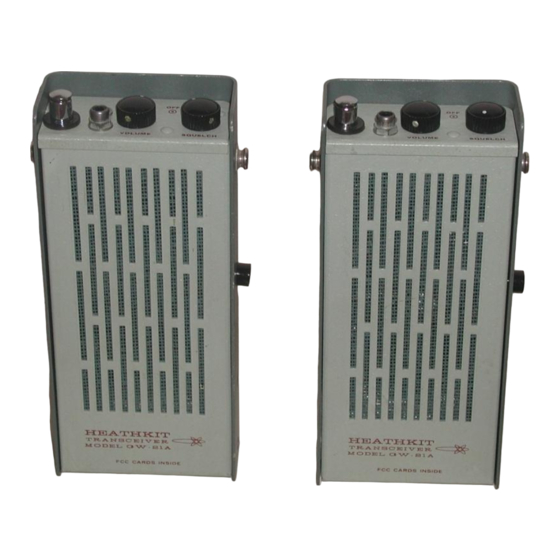
Advertisement
Quick Links
The Heathkit GW-21A Hand Held Germanium Transistor Transceivers.
(Dr. H. Holden. Jan. 2022)
Carry straps for the GW-21A
INTRODUCTION:
By the early 1960's many Germanium transistor types had been produced and some
were capable of excellent high frequency performance.
In Europe, the typical types were the OC169, OC170, OC171. Also the similar
AF114 to AF117 series which were ultimately replaced by the AF124 to AF127
series, the former parts all being affected by Tin Whisker disease.
In the USA there were a number of 2N prefix types, such as the 2N2084, made by
Amperex which had similar performance to the AF124. The RF capable transistor
Advertisement

Summary of Contents for Heathkit GW-21A
- Page 1 The Heathkit GW-21A Hand Held Germanium Transistor Transceivers. (Dr. H. Holden. Jan. 2022) Carry straps for the GW-21A INTRODUCTION: By the early 1960’s many Germanium transistor types had been produced and some were capable of excellent high frequency performance. In Europe, the typical types were the OC169, OC170, OC171. Also the similar AF114 to AF117 series which were ultimately replaced by the AF124 to AF127 series, the former parts all being affected by Tin Whisker disease.
- Page 2 Germanium transistor based hand held compact transistor transceivers, like the Heathkit GW-21A, started to appear in stores and in popular culture, on the TV and in the Movies too. Below is a frame cut from an early 1960’s Voyage to the Bottom of the Sea TV show, where a Heathkit GW-21 transceiver was being used to save the day.
- Page 3 Heathkit GW-21 and GW21A transceivers. (These are apparently identical units, except for the transistor types used). Recently I came across a pair of Heathkit’s GW-21A’s on eBay. I had seen these in my childhood on TV and always wanted them. So for nostalgia’s sake at least, I decided to buy them and restore them.
- Page 4 While I was able to easily find the schematic for the GW-21A, the original Heathkit manual was more difficult. Possibly, one reason why the manual for the GW-21A is difficult to acquire online is noted below. This was an interesting revelation, because normally in the field of Amateur Radio, or CB radio, there is a spirit of sharing and cooperation.
-
Page 5: Circuit Description
(IF) transistor. Typically, in most Superhet radios, with a 455kHz IF channel, the receive oscillator frequency runs 455kHz higher than the incoming carrier wave. In my GW-21A radios, the transmit crystal and transmit frequency is 27.085MHz (Channel 11 of the Citizen’s band) and the receive oscillator crystal in the converter stage is 27.540... - Page 6 RF output stage, when the unit is in transmit mode. RESTORATION OF THE TWO GW-21A UNITS: Both the units arrived in good condition and fortunately there was no evidence of previous repairs or modifications.
- Page 7 Also one final check is to compare the two audio amplifier sections for gain and power output, comparing the two GW-21A units. I was satisfied that the audio stages were normal in both units and that all the original audio transistors, RCA 2N407...
- Page 8 IF amplifier without the requirement for Neutralization. You will notice from the GW-21A schematic, it is a non-neutralized 455kHz IF. The A1384 transistors in the RF stage, converter stage and transmit oscillator stage were all good in both units.(Note: these are not 2SA1384’s, they are an Amperex part).
- Page 9 I also found that there were some capacitive coupling effects to the transistor body. In these Heathkit radios, all of the transistor sockets are 3 pin. There is no shield connection. I found the quick solution for the 2N2084, was to simply connect its shield (case) wire to its emitter wire (which is at common, from the radio frequency perspective).
- Page 10 In lieu of talking into the speaker for testing, with the speaker replaced by a 10 Ohm dummy load and in the transmit mode, a 1kHz sine wave modulation signal was applied from a signal generator. The generator output was set on 0.5V peak or about 350mV rms and a series 3.3k resistor used to deliver the signal across the 10 Ohm dummy speaker resistance.
- Page 11 RF output power is ¼ that, at about 26 mW. It appears likely that the suggestion that these GW-21A radios had a 100mW RF output, was probably referring to a PEP measurement, not an unmodulated carrier wave power which is ¼...
-
Page 12: Receiver Alignment
A small antenna was attached to the generator output and L1 and L2 adjusted again with the GW-21A’s antenna extended with the unit some meters from the generator. This is done in case the attachment of the generator had caused some de-tuning effects, but it turnout out the slugs of L1 and L2 were in the correct positions. - Page 13 The photo below shows the two restored units with the batteries fitted. SUMMARY: The GW-21A’s are a remarkable early Germanium transistor hand held transistorized transceiver. While they don’t have a spectacular RF output power, only 100mW PEP, compared to modern transceivers, they make up for that by having a very sensitive Superhet receiver.












Need help?
Do you have a question about the GW-21A and is the answer not in the manual?
Questions and answers